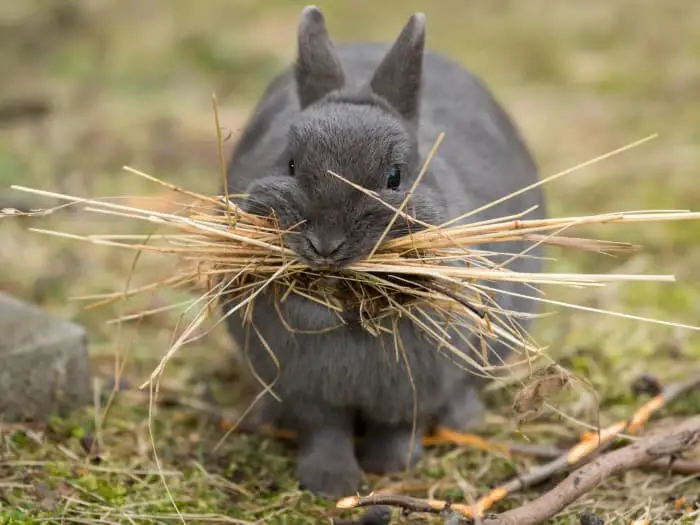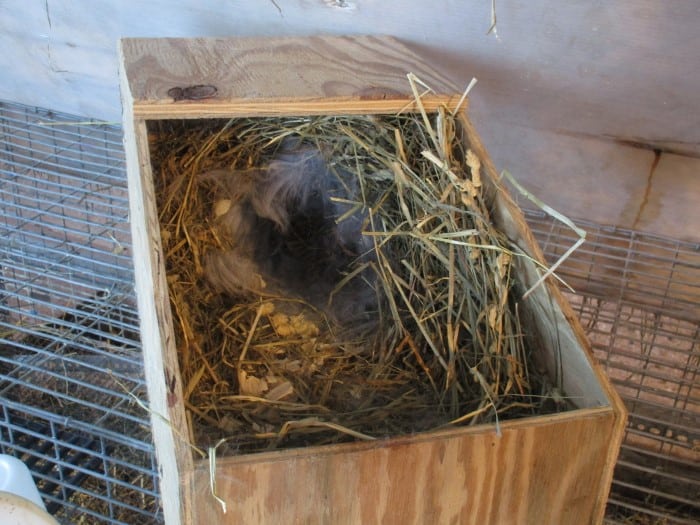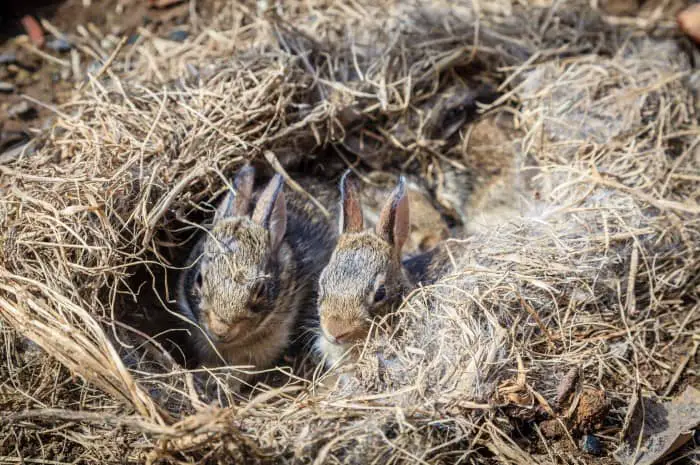When you have several rabbits, including a female, and they are not spayed or neutered, there may come a time when they get together and give birth to kits. Rabbits are animals that can breed with ease so we are going to explore how to care for a rabbit nest. A doe can have an average of 8 kits per litter. The gestation period takes only one month, and as soon as they give birth, rabbits can become pregnant again.
If you have decided that it is time to have your rabbits bred, you have to learn some basic facts before committing yourself to such an adventure, so that there are no issues to regret. You need to be prepared for when the time comes to give birth.
What is the First Thing You Need to Know?
The first thing you should know is that, unlike many other animals, rabbits do not have a regular oestrus cycle. Rabbits are induced ovulators, that is, ovulation takes place after stimulation due to mating, usually 12 hours later. Sometimes ovulation can be caused by the proximity of an intact male. For this reason, they can reproduce throughout the year.
Separating the Mother and the Father
You must separate the mother from the father before birth if you want to avoid conflicts. These are some of the most important reasons for doing so:
- Pregnant females will protect their nests and, therefore, often behave more aggressively than usual during this stage.
- Both mother and kits will be less stressed.
- Female rabbits can conceive right after birth, thus the importance of separating the mother and the father. Otherwise, they will probably have a new litter after 30 days. If you want to have your buck neutered, now is the perfect time to do it.
Moreover, you should also consider timing. The wellbeing and health of the doe and her kits rely upon your considerations and adequate planning.
Why Is It So Important to Know the Exact Date of Ovulation?
Knowing the exact date of breeding is extremely useful, as it will give you an idea of the precise length of the pregnancy. This will allow you to provide the proper care for your doe. A rabbit gives birth approximately thirty-one days after breeding. You must consider this before making any plans.
In the wild, rabbits can manage on their own to carry out their pregnancies. They get everything they need from their environment. However, this is different for rabbits in captivity. They depend on us to get everything they need.

By keeping a record of their breeding date, you will know their due date with certainty. In this way, you will know how to plan and prepare your rabbit for birth. This will also allow you to plan and determine if you can be available for kindling, in case there are any complications, and your rabbit needs help. Good record keeping is especially important when breeding, as you could easily get the kindling date wrong, which can result in the potential loss of kits.
How to Care for a Rabbit Nest?
The rabbit will need a nest box to have privacy at the time of birth and for the young rabbits to have a warm and safe environment. Nest boxes are essential for kits’ survival. Rabbits in the wild usually make their burrows in the ground. Pet rabbits cannot do this, so it is our responsibility to offer them everything they need.
Some rabbit breeders prefer nest boxes made entirely of wood and you can even make your own, these boxes keep the rabbits warmer and I would recommend them for this reason. However so you are aware some breeders use galvanized steel boxes. These boxes usually possess a sliding plywood bottom. Galvanized steel boxes are easier to clean and to disinfect. Another popular type of box looks like a wire mesh basket. These boxes can be lined with cardboard that can be thrown away if it becomes dirty or can be easily replaced between litters.
How Do We Set Up the Nest Box?
You can build these boxes with any type of wood or you can buy them if you prefer. The ideal dimensions of a nest box for an average size rabbit are approximately 18 x 10 x 8 inches. Its top must be covered to give the rabbit more privacy. It’s a good idea to include a small shelf towards the top of the box that serves as a safe place where the mother can rest from her restless babies.

You should place clean and dry bedding in the nest box, although the rabbit will pluck its fur to make a nest. This is particularly useful when rabbits end up kindling during cold weather. We can offer them different materials such as grass, wood shavings, straw, or hay so that she can build her nest as she pleases.
Whichever nest box you choose, make sure you sanitize it between every litter. You can use a 1 part bleach to 5 parts water solution for this purpose.
Mommy’s Duties
The doe will now take over and will set up the perfect nest for her kits. She will also pluck hair from her belly, her sides, her neck, and from under her chin to make the nest warmer and cozier. She will also use the plucked hair to cover and protect its kits from cold. The doe may eat some of the bedding, so it must be replaced often.
When Should I Place the Nest Box in the Cage?
There are different opinions regarding when to place the nest box in the cage. Some breeders say that you should wait a day or two before the kindling. Others say that you must put it in a little earlier so that the rabbit gets used to it. A couple of days before kindling, the female rabbit will begin to build its nest. You must pay attention to the signs that indicate that the time of labor is approaching.
The first thing you will notice is that the doe will eat less or stop feeding a day before the kits arrive.
The second thing you will notice is that it will start jumping around the cage, collecting in its mouth the nesting material you provided to create a cozy nest. However, each rabbit is different. Some rabbits can start building their nest on the same day, while others might do it a couple of days before kindling.
As mentioned above, the doe will also start to pluck its fur and will begin lining the nest with it. Not only does the fur help keep its kits warm, but the lack of it on its belly allows for easier access to its nipples.
Most rabbits build their nests only hours before the kits arrive.
Where Should the Nest Box Be Placed?
The nest box should be placed apart from the mother’s usual resting spot. Remember that in the wild, rabbits visit and feed their young twice a day for only about 5 minutes. This behavior is done to avoid drawing the attention of predators. Does must have the chance to retreat entirely from the litter. If not allowed to do so, the mother can become frustrated and can even damage her kits and cause infant mortality.

Also, make sure that you place it in the opposite corner from where the rabbit leaves most of its droppings. You don’t want the nest’s box to be over its potty.
As kits grow up, they will need more room for jumping and developing good motor skills. Therefore, for the well-being of the mother and its kits, they should be provided with adequate nests and quiet environments.
The Importance of a Peaceful Environment
Does are usually good mothers, but it is essential to provide adequate environments for the rabbits to feel safe and comfortable. Kit mortality increases in stressful conditions. Does will appreciate a peaceful environment.
A frightened rabbit may end up eating its litter or refusing to feed them. Poor housing, the failure to withdraw from the kits, and the proximity of other females, even if kept in separate cages, are triggering factors that can lead to infanticide.
Should We Intervene During the Kindling?
Usually, it is not necessary to intervene when the rabbit is giving birth. You just need to remain vigilant and ready to take action in case of any eventuality. Even though a rabbit manages quite well on its own, sometimes, our intervention may be required. When is it necessary to interfere?
- After birth, we should check how many kits there are. If there are any dead kits, you will have to remove them to avoid the others getting sick.
- You must make sure that none of the kits remain outside the nest. If one of the kits falls outside the box, you must immediately take it back to the nest and have it covered, before its body temperature begins to drop. If they are cold, you will have to warm them up before putting them back in the box. Warm towels or heating pads can be useful for this purpose. Wrap the heating pad with a towel and set it at the lowest heating level, so they do not get burned.
- Watch your doe’s behavior. Kits usually nurse once or twice a day for only four to five minutes. If you observe that the doe is not breastfeeding, place her inside the nest box until the kits start to nurse.
Occasionally, litters can be too big, and it can become quite challenging for the doe to feed each bunny. In these cases, it is advisable to transfer some of them to another mother with fewer kits as long as the young are more or less the same age. Most rabbits will accept babies from another doe without problems.
Finally, a successful breed will depend to a great extent on the attention and care that we give to both the mother and the young. Anyway, you should never forget to consult your vet to make sure that everything is going well. Adopting the necessary measures, you will soon be enjoying a beautiful litter.
